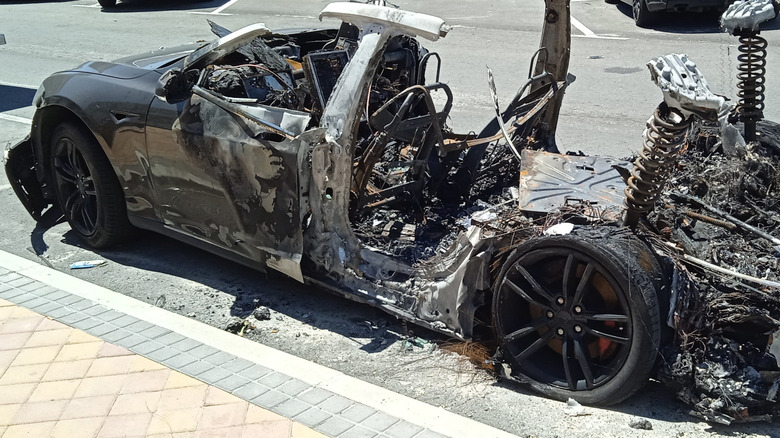Tesla Cybertruck Explosion At Trump Hotel Was No Ordinary EV Accident
Shortly before 9 am on January 1 2025, a blast rocked the Trump Hotel on the Las Vegas Strip. Footage soon appeared showing a Tesla Cybertruck exploding in a shower of sparks, and subsequently bursting into flames. While EV fires aren't unheard of, there seems to be more to this particular blast than meets the eye.
Speculation on social media was soon rife, with some observers noting that the explosion looked like fireworks. Elon Musk himself posted on X stating "The whole Tesla senior team is investigating this matter right now. Will post more information as soon as we learn anything. We've never seen anything like this."
It was later noted that the explosion was caused by an improvised explosive device consisting of fireworks, gas tanks, and camping fuel. The driver of the rented electric pickup was confirmed dead, with seven others suffering from minor injuries.
We have now confirmed that the explosion was caused by very large fireworks and/or a bomb carried in the bed of the rented Cybertruck and is unrelated to the vehicle itself.
All vehicle telemetry was positive at the time of the explosion. https://t.co/HRjb87YbaJ
— Elon Musk (@elonmusk) January 1, 2025
Musk also took to X to highlight: "We have now confirmed that the explosion was caused by very large fireworks and/or a bomb carried in the bed of the rented Cybertruck and is unrelated to the vehicle itself."
The Tesla CEO also claims that the truck's construction prevented a far worse incident. Posting again on X the billionaire said: "The evil knuckleheads picked the wrong vehicle for a terrorist attack. Cybertruck actually contained the explosion and directed the blast upwards. Not even the glass doors of the lobby were broken."
At the time of writing, authorities are investigating the blast as a possible terrorist act, and exploring possible links to an incident in New Orleans that occurred a few hours before.
What normally happens when an EV catches fire
According to current data, a traditional internal combustion engine vehicle is ten times more likely to catch fire than an EV–but electric cars do go up in flames every now and then. As for why they catch fire, there are several potential causes including manufacturing defects, software glitches, and damage to the batteries themselves.
Unfortunately, when an EV does ignite, the batteries can enter a state known as "thermal runaway." That's when the heat generated by battery cells that are currently on fire causes nearby cells to combust too. This can make EV fires particularly tricky to put out: the lithium within the batteries tends to be the fire's fuel source, and attempting to douse the flames with water will only make matters worse. The water will violently oxidize the lithium, and make the blaze more intense.
Extinguishers that use compounds like dry chemical, copper powder, CO2, extinguishing foam, powder graphite, or sodium carbonate can be used to tackle EV fires, though putting them out is still a challenge. There is also the danger that the fire could start again seconds, days, or even weeks after the initial blaze.
As a result, letting a battery simply burn itself out in a safe environment is sometimes the best solution. In August 2024 a Tesla Semi, which has one of the largest battery banks of any electric vehicle, caught fire in California. 50,000 gallons of water were used and fire retardant had to be dropped via aircraft as crews battled the blaze. In addition to the flames, the fumes emanating from the burning truck were also a potential health issue.

